Plantago spp.
Why would anyone bother to grow plantain?
Largely ignored by the modern gardener, and often regarded as an irksome weed, plantain is one of those overlooked and often ridiculed plants that actually has quite a lot to offer.
Once we learn to appreciate it, that is.
With edible nutritious leaves, medicinal value, and ecological importance, this plant is really worth a second look.
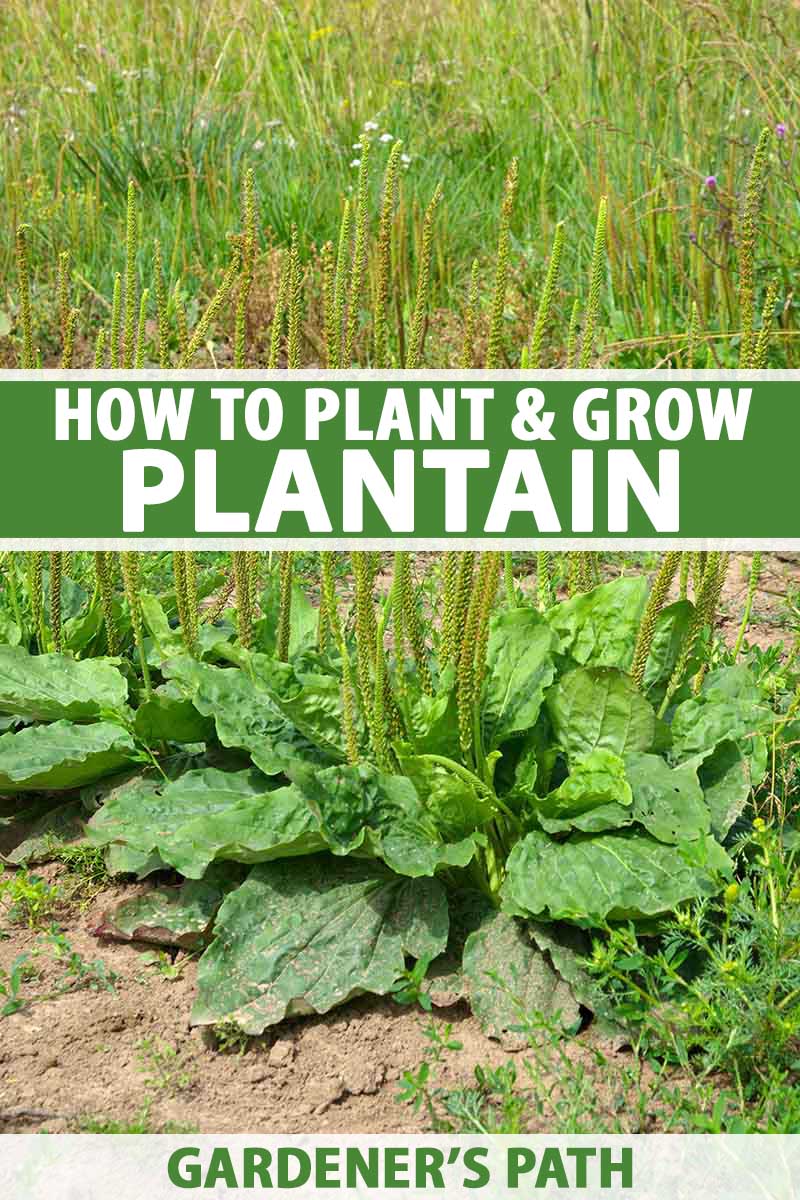
We link to vendors to help you find relevant products. If you buy from one of our links, we may earn a commission.
Luckily, many gardeners are beginning to spread the word about the true value of this useful medicinal herb.
What You’ll Learn
What Is Plantain?
Commonly found growing in lawns and disturbed areas, once you learn to identify this herbaceous perennial, you will likely start noticing it everywhere.
There are about 200 species in the Plantago genus. The three most common varieties found in the US are broadleaf plantain (P. major), Rugel’s plantain (P. rugelii), and ribwort plantain (P. lanceolata).
All of these are known by many additional common names, and all are used in herbal medicine.
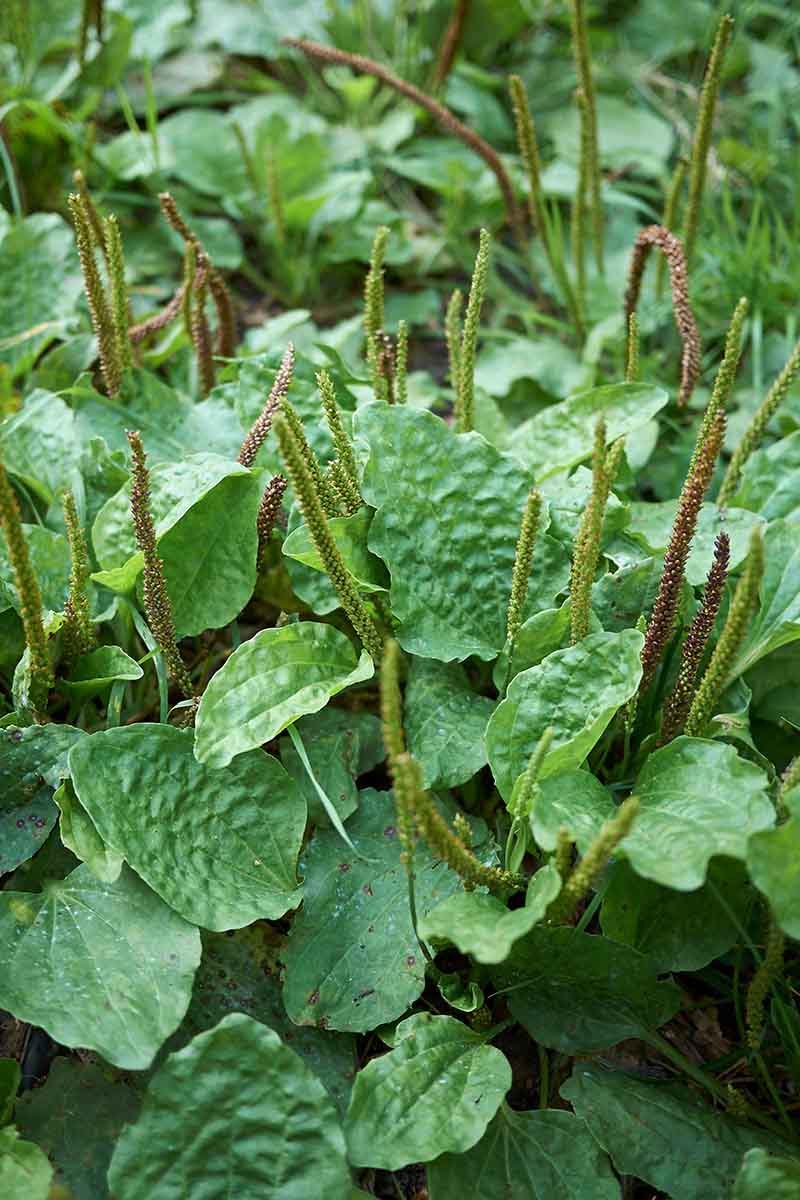
Broadleaf plantain is a compact perennial flowering herb that has low growing, egg-shaped, waxy green leaves with prominent veins. It’s also known as birdseed, broadleaf plantain, healing blade, and hen plant.
Said to have been brought to what is now the US by the Puritans, some Native Americans called it “white man’s footprint.” Foliage can grow to about six inches long and four inches wide.
In late summer, it produces a green, leafless stalk that rises above the leaves, with long, spiky clusters of tiny, densely packed greenish-brown flowers with purple stamens.
Named for 19th century German botanist Ferdinand Ignatius Xavier Rugel, Rugel’s plantain looks similar to broadleaf, and the two are often confused.
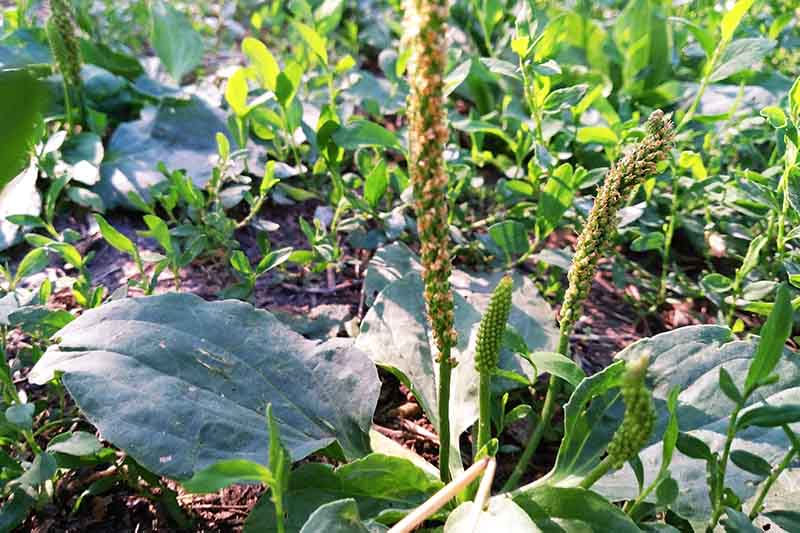
Its wide, viened leaves are slightly lighter green and have less of a waxy feel to them. The base of the petioles where leaves attach to stems may also be purple or reddish, and it produces densely packed spiky clusters of off-white flowers.
It’s also known as American, blackseed, or pale plantain.
Ribwort or English plantain is much taller, with thin, lance-shaped leaf blades that are rarely more than an inch in breadth. In fact, it’s sometimes called narrowleaf plantain, as well as ribleaf, buckthorn, or lamb’s tongue.
The leafless flower stalks can be more than two feet long with pointed, dense flower spikes. Flowers are brownish green, with long white stamens.
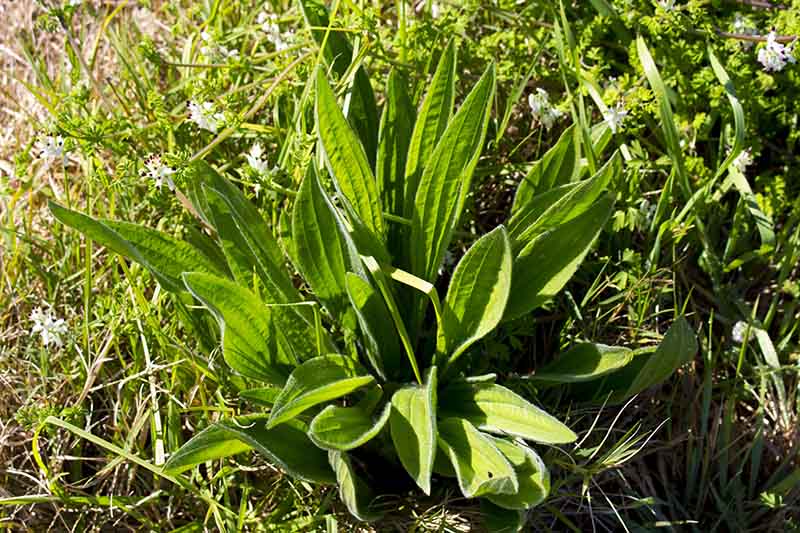
All of these species grow readily in disturbed, compacted soils, including rocky and sandy terrain, and can be found in abundance all over the place, particularly in USDA Hardiness Zones 3-9.
As such, this plant plays an important ecological role in revitalizing disturbed and compacted soil.
As plantain spreads to cover an area (and it will spread, thanks to the many thousands of seeds that it produces each season), the fibrous roots break up hard, compressed soils, simultaneously preventing erosion by holding the earth in place.
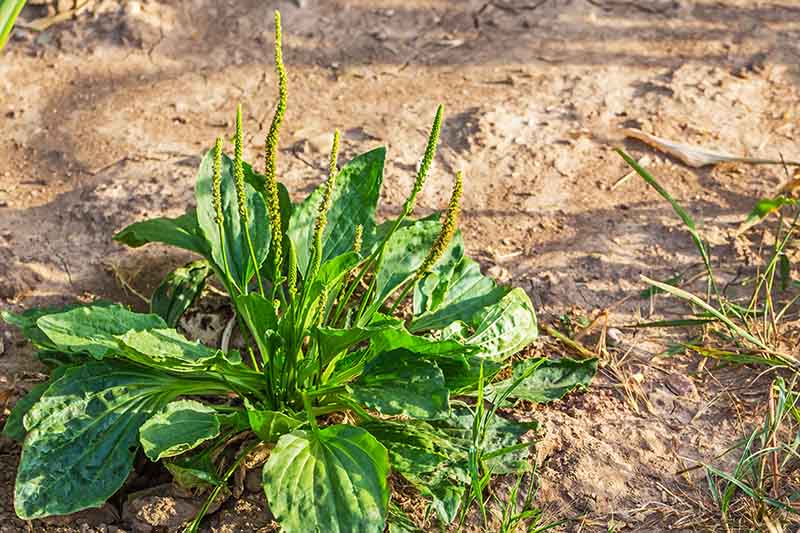
While many think of it as a weed these days, plantain has not always been regarded as such, and it has in fact been used in food and medicine for thousands of years.
Cultivation and History
Both broadleaf and ribwort plantain are native to Europe and Asia, and Rugel’s originated in North America. But these species and many others can be found growing all over the world.
A highly accessible and abundant healing herb, plantain has been used in herbal medicine for a very long time.
Around 327 BC, Alexander the Great was said to have noted the culinary and medicinal use of plantain while in India, and brought the plant back with him to Europe.
The Lacnunga (or “Remedies” in English), an Anglo-Saxon collection of medical texts from the 10th century CE, included plantain as one of nine sacred herbs used in combination as a cure for poisoning and infection.
Even Shakespeare mentioned it in several of his plays.
“Your plantain leaf is excellent for that… for your broken shin,” Romeo says to Benvolio. As Shakespere references, this herbal remedy has long been used as a salve for scrapes and minor injuries.
But Romeo also dishes out the same medicine Benvolio has given him with his mockery, insinuating that Benvolio has offered little help for his love-sickness.
Medicinal Use of Plantain
Referred to by herbalists as a vulnerary herb, this plant is perhaps best known as a remedy that may help to heal wounds.
It contains slippery mucilage that is soothing and healing to the skin, and is often applied topically to treat all kinds of minor wounds, including insect stings and bites, allergic rashes such as those from poison ivy and stinging nettle, hives, burns, cuts, and abrasions.
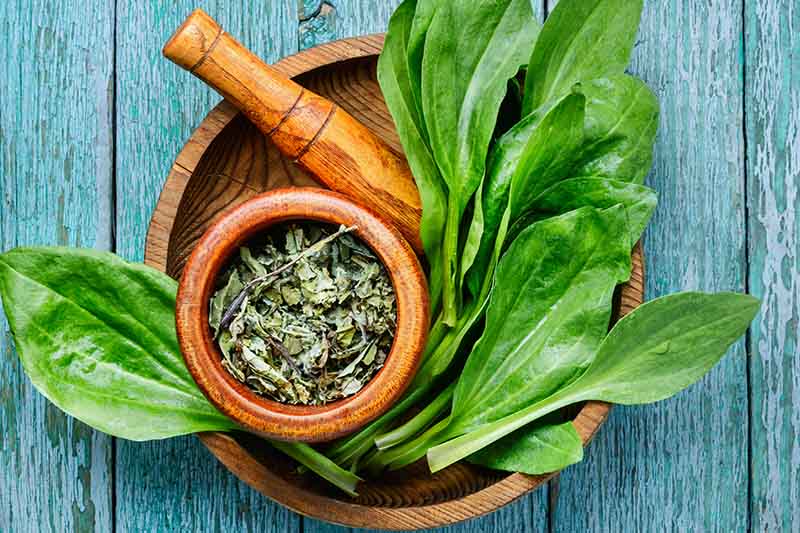
It is also prepared as a poultice to draw out splinters or glass.
To make a poultice, crush or blend the herb into a paste and apply it to the affected area. Wrap the mixture with gauze or a bandage to keep it in place.
Leaving it on for anywhere from 10 minutes to overnight is recommended, reapplying the mixture every few hours if needed.
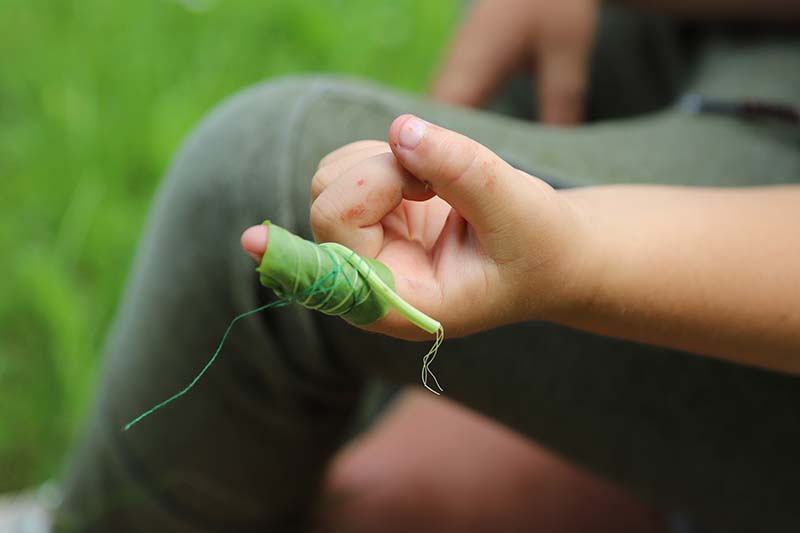
As this herb is soothing and anti-inflammatory, it is also sometimes taken internally to alleviate gut inflammation and respiratory problems, such as chronic bronchitis, irritable coughs, and sinusitis.
And it’s used in herbal as well as commercially available laxative blends – Rosemary Gladstar says in her book “Herbal Recipes for Vibrant Health” that the “psyllium seeds used in Metamucil are produced from a Plantago species.”

“Herbal Recipes for Vibrant Health” available on Amazon
This plant is edible, nutritious, and safe for use by children and even animals.
Plantain Propagation
Cultivating this plant takes very little effort. This prevalent garden weed is going to grow under the right conditions, whether you want it to or not.
You can easily forage for plantain. But if you want to try to cultivate a patch, just find a spot in the garden that suits you. Pretty much anywhere is fine. This perennial will grow in full sun or part shade, in virtually any soil type.
It may be grown from seed or transplants.
From Seed
Direct sow seeds in the spring. The seeds are tiny, and plants produce many of them. Broadcast them over your selected area, and barely cover them with soil. Keep the soil moist until they sprout.
To increase germination rates, you can cold stratify seeds before planting by placing them in the refrigerator for a few weeks.
Seeds are spread by the wind, and this plant will self sow readily. If you already have a few plants growing around the garden, either collect the seed yourself after flowering, or allow plants to self-sow around your garden to grow next season.
Transplanting
If you find some growing wild, you can dig them up and transplant elsewhere to encourage spreading wherever you like.
This plant is easy to transplant since it has shallow, fibrous roots, plus a stronger taproot. You can encourage a patch to grow wherever you want it to by moving a few plants to the area.
Be careful to keep the taproot and as many of the more fibrous roots intact as you can when you dig, and plant them to the same depth at which they were growing elsewhere. Water well, and watch ‘em grow.
How to Grow Plantain Plants
You should keep the soil moist until seeds start to sprout, but once the plants are established, required maintenance is minimal.
There really isn’t much that needs to be done to keep them going, and they will happily grow and spread! All you have to do is wait until it is time to harvest.
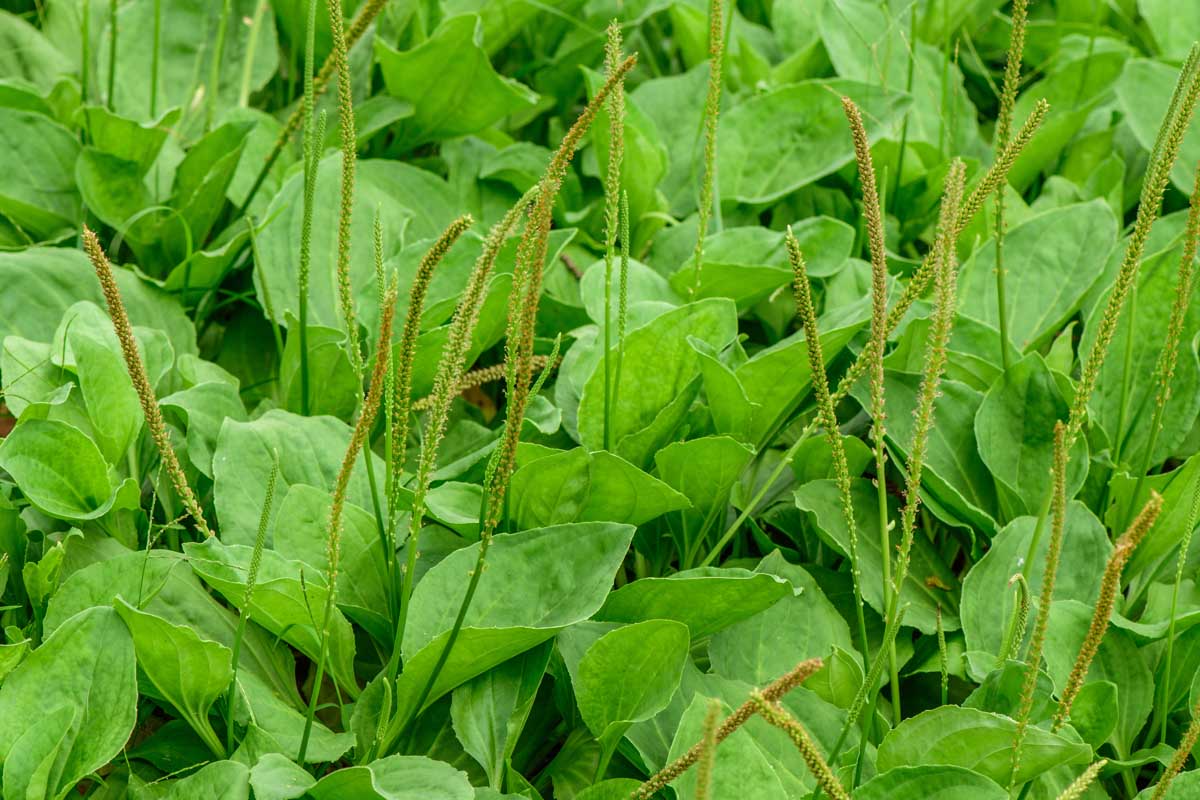
Plantain can survive mowing or trampling in high-traffic areas of the yard, it can be planted in clay soil, and it can even help to keep the soil in place in areas prone to erosion.
But if you plan to pick the tender young leaves to add to your salads, or you wish to use them to make tea or other herbal medicines, it’s best to dedicate a more protected spot in your garden to growing this plant for edible use.
Growing Tips
- Seeds grow best when given a period of exposure to low temperatures prior to sprouting. Taking the time to cold stratify your collected seeds before planting will increase germination rates.
- To keep the herb from spreading to other parts of the garden where it is less desirable, you may want to grow it in an entirely separate area. If the herb does start to creep into parts of your yard where it isn’t wanted, just dig the whole plant up and either harvest it, or move it to your designated garden bed.
- You can also plant it in compacted soil that you wish to improve for future crops, or areas in danger of erosion.
Where to Buy Plantain Seeds
Because this plant is often considered a weed, it is not always easy to source seed commercially.
Generally, your best bet is to find some growing nearby and either transplant it, or harvest and save the seeds to sow in the springtime.
A few options are available online as well.
P. major seeds are available for purchase from Earthbeat Seeds in packets of 100.
Or, if you prefer the English variety, P. lanceolata seeds are available from Earthbeat Seeds in packages of 100.
Managing Pests and Disease
Plantain plants are hardy, with a tendency to thrive in adverse conditions – that’s why they’re known as weeds by many people, after all!
You shouldn’t face many issues when growing this plant at home. Here are just a few problems to keep an eye out for:
Herbivores and Omnivores
Plantain provides food for all sorts of wildlife. Herbivores including rabbits, deer, cattle, and sheep may munch on the greens and flower stalks.
Omnivores including groundhogs (aka woodchucks) and songbirds may stop by to eat the leaves or seeds as well.
Insects
Several types of insects may also like to visit your plantain crop as a source of food, though visits from friendly pollinators are uncommon. If you’re growing enough, you should have plenty to share with the bugs!
Aphids
These small insects like to suck sap from leaves, damaging plants. Management is generally not necessary, however, as it is unlikely that an infestation will get out of control.
If you see them, knock them off with a strong spray from the hose.
You can read more about aphids here.
Buckeye Caterpillars
Junonia coenia, or common buckeye butterflies, lay single eggs on plants, as opposed to the clusters of other types of butterfly eggs that you might see on other host plants around the garden.
Their larvae like to munch on the leafy greens.
These caterpillars are solitary creatures who tend to live alone, and they shouldn’t cause too much damage overall. Pick them off and move them elsewhere, if you like.
Flea Beetles
These small jumping insects chew small holes in leaves, which may result in wilting or stunted plants.
In the unlikely event that an infestation becomes serious, try placing sticky traps around the garden bed to capture these beetles.
Read more about flea beetles here.
Disease
Few diseases tend to plague plantain, but be sure to keep an eye on maintaining proper airflow between plants, particularly during extended periods of rain and high humidity.
Powdery Mildew
Plantain may be susceptible to powdery mildew. This fungus causes lesions to appear, which can eventually spread over entire stem and leaf surfaces.
A mixture of baking soda, dish soap, and water sprayed on plants can help to keep mildew in check.
We have a guide to treating powdery mildew here.
Harvesting Plantain
Leaves can be harvested at any time during the growing season – before, during, or after flowering.
The most important thing to keep in mind is that you want to harvest the fresh inner leaves. The outer ones, which are older, tend to be tougher. Just snip off the leaves as you need them and enjoy!
Early-season harvests tend to be best for making tinctures.
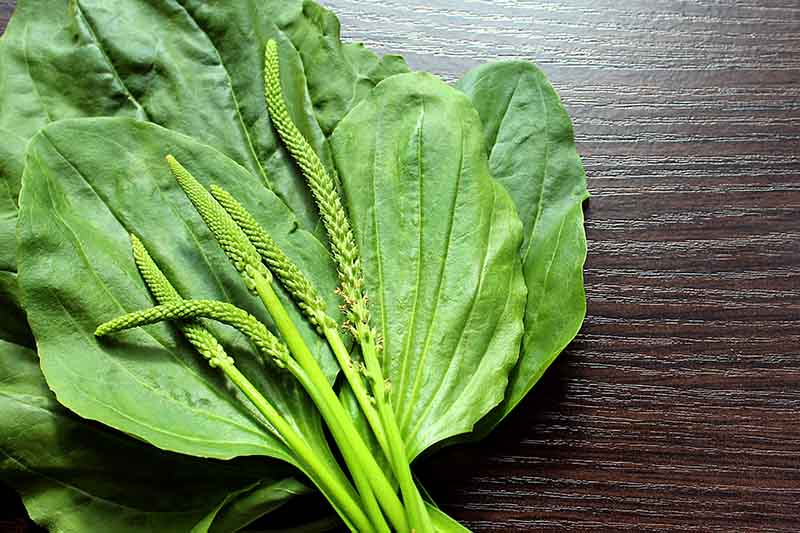
Seeds can be harvested when the heads are fully developed, drying, and starting to turn brown.
You can check if they are ready to harvest by taking a seed head and shaking it against your hand. If seeds come flying out, they are ready to go.
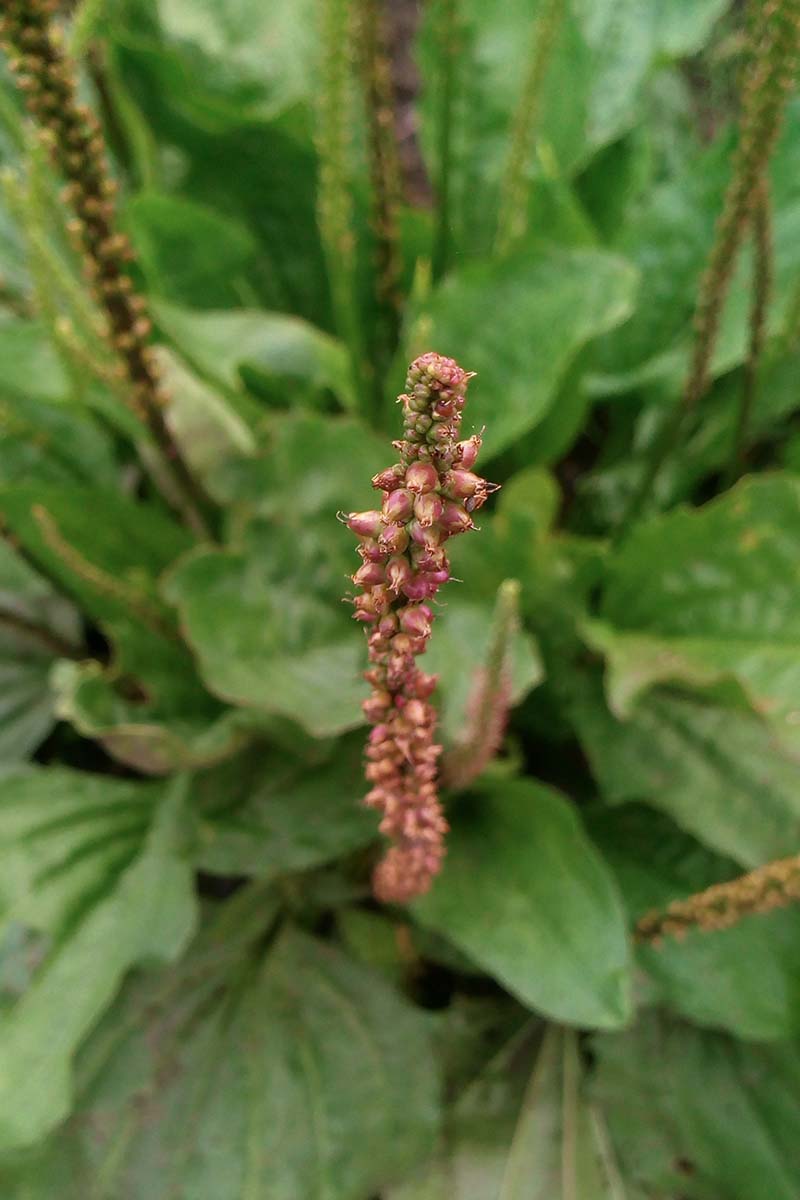
Run your fingers up the dried stalks one at a time to gently pull off the seeds. Collect them in a plastic bag.
Sift the seeds through a fine strainer a couple of times, and then blow on them gently to remove the husks.
The roots are also used in medicine, though less commonly.
Root harvest is best done in the fall, when the plants’ energy is directed downward, away from the leaves. Just pull up a plant and gather the roots.
Don’t worry too much about over harvesting, as this plant will likely keep coming back no matter how much you take out.
When foraging for wild plantain, be sure to pay attention to where you are getting it from, and be cautious about harvesting plants grown in potentially contaminated areas. Avoid roadsides, driveways, unfamiliar terrain, and areas that may have been sprayed with herbicides.
Preserving Plantain
While this plant is best used fresh, especially for topical application, you can dry the leaves to use them for tea or to make herbal washes.
To dry the leaves, dehydrate them at 95°F until they are crumbly, checking their texture occasionally until they are dry.
You can also lay them on a screen or tray in a dark, dry location to dry, or hang them upside down in bundles.
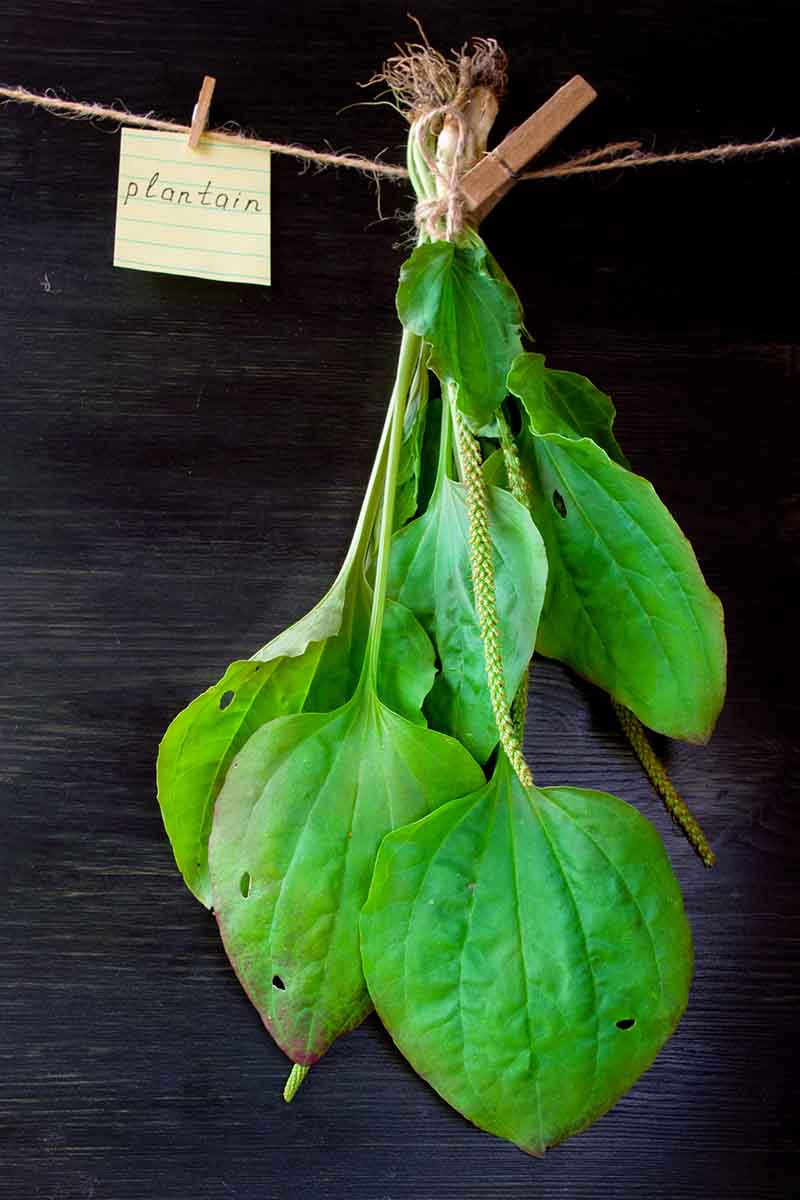
Once the leaves are fully dried, store them in a tightly lidded jar in a dark cupboard.
Find more tips for drying herbs here.
You can also make a tincture with the fresh herb so you will have a stock of plant medicine available throughout the year.
To do this, simply fill a glass jar with fresh plantain leaves and top it with 30 to 40% alcohol. Cover the jar tightly and place it in a dark location for four to six weeks, shaking it daily to agitate the mixture. Strain and transfer to a dropper bottle.
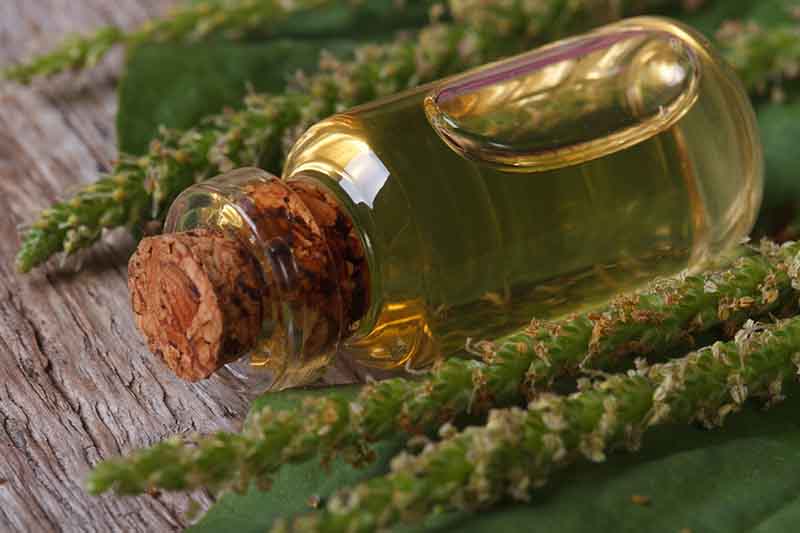
You could also try making an infused oil or salve with the fresh leaves. This is a wonderful way to store this herb for topical use anytime you need it.
Start by filling a glass jar with fresh leaves and top with a carrier oil.
Olive oil is my preference, as it has a long shelf life and is more affordable than some other types of oil, but jojoba, coconut, almond, or avocado oil are also great choices.
Let the herb sit in the oil for about four to six weeks, shaking the jar daily. You can keep it in the sun for the first few days, then transfer it to a dark cupboard for the remainder of the time.
Once the oil is ready, you can strain it and use it as is, or combine it with beeswax to make a healing salve.
To make a plantain salve, prepare a double boiler and fill it with one part herbal infused oil and one part beeswax. Stir over low heat until melted.
Next, pour the liquid into tins or small glass jars and leave them on the counter to set. The salve will harden at room temperature.
For a wonderfully soothing salve, try adding additional herbs such as calendula, yarrow, comfrey, and jewelweed. You can also add a few drops of lavender or peppermint essential oil for a final, therapeutic and aromatic touch.
Cooking Ideas
The leaves of this plant are edible and nutritious, with a slight bitterness and a generally mild flavor. They’re rich in calcium, as well as vitamins A, C, and K.
You can eat the young leaves raw in salads, or blend them into juices or smoothies.
They can be cooked in stir fries and stews, adding a flavor and texture similar to spinach. Dried leaves can be crumbled and added to soups or cold blended beverages.

Fresh or dried leaves can also be brewed as a tea. To make an infusion, add 1-2 teaspoons of the dried herb to a cup of water, or about double that quantity if the herb is used fresh.
The seeds can also be soaked in room temperature water to make a cold infusion.
Quick Reference Growing Guide
| Plant Type: | Herbaceous perennial, medicinal herb | Water Needs: | Low |
| Native to: | Europe, Asia, North America | Maintenance: | Low |
| Hardiness (USDA Zone): | 3-9 | Soil Type: | All |
| Season: | Spring-fall | Soil pH: | 5.6-7.0 |
| Exposure: | Full sun to partial shade | Soil Drainage: | All |
| Time to Maturity: | 90-120 days | Tolerance: | Poor soil, compacted soil |
| Spacing: | 1 foot | Attracts: | Flowers occasionally attract bees, Syrphid flies |
| Planting Depth: | 1/16 inch | Family: | Plantaginaceae |
| Height: | P. major, P. rugelii: 6 inches; P. lanceolata: 2 feet | Genus: | Plantago |
| Spread: | 4-6 inches | Species: | lanceolata, major, rugelii |
| Common Pests: | Aphids, buckeye caterpillars, katydids (Conocephalus brevipennis), leaf-miner fly larvae (Phytomyza plantaginis), flea beetles, weevils (Mecinus pascuorum, M. pyraster) | Common Disease: | Powdery mildew |
One Person’s Weed Is Another Person’s Treasure
Some may look at plantain as a weed. But like so many throughout history, I see this as an herb that offers many benefits, and one of the most convenient to have on hand.
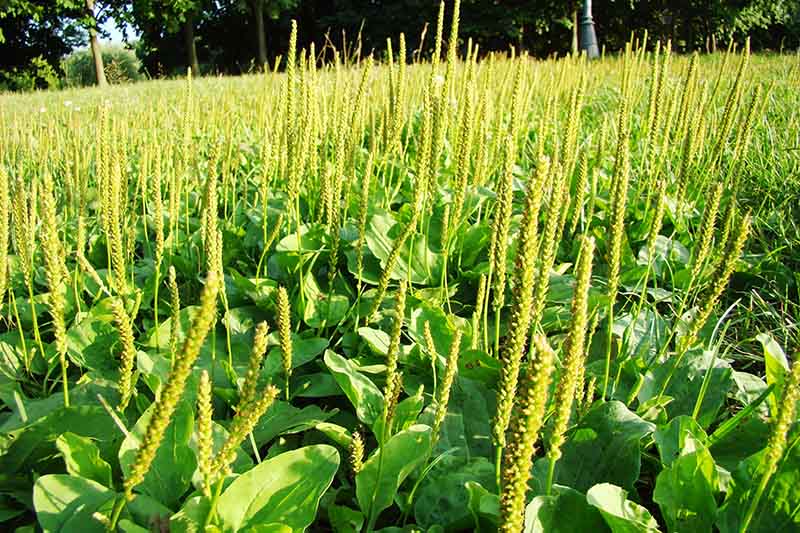
Next time you get cut or bitten while gardening, just throw some mashed up plantain on your wound, and see for yourself how handy it can be!
Do you have experience growing or using plantain? Share your thoughts in the comments below!
If you are looking for more medicinal plants to add to your garden, you’ll need these guides next:
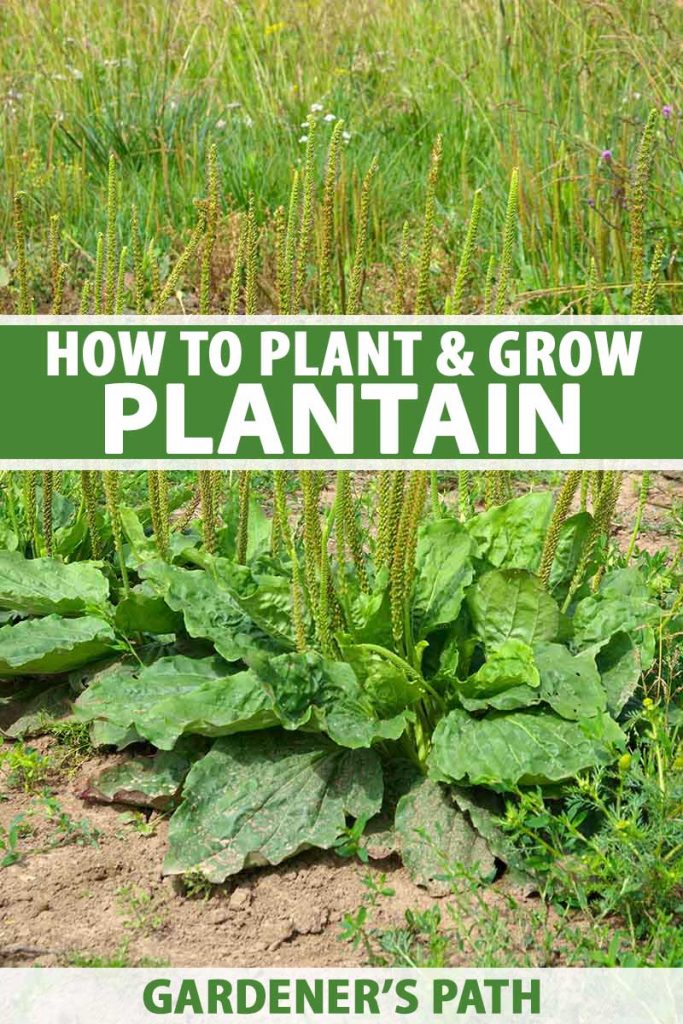
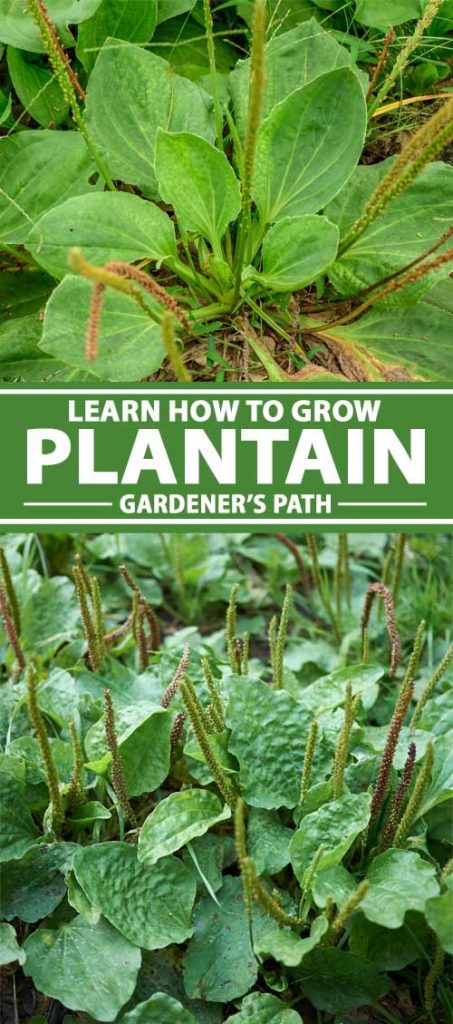

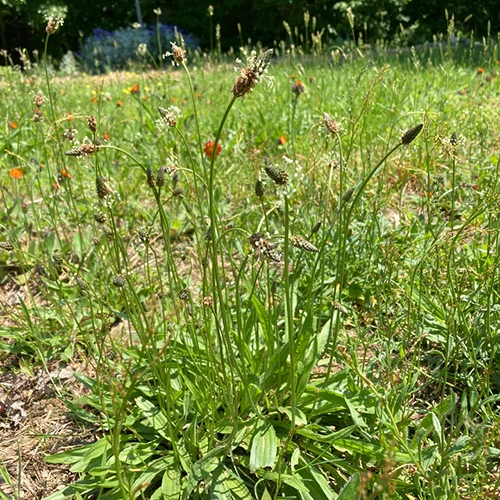
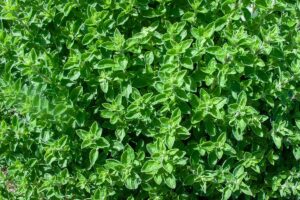
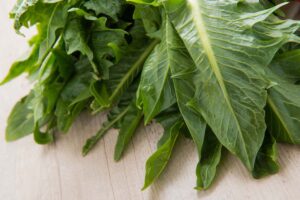

Thank you for writing this article. I found a variegated plantain with white/pink edged leaves – this info gave me the confidence to transplant it to try to preserve it and hopefully propagate a new variety.
Such a wonderful informative article. I have been using fresh wild narrow leaf plantain leaves for the past couple of years for my little boy whenever he has any skin rash or insect bites and the result is miraculous. Just in a day rash goes away. I am even considering making a product out of it and I am doing a lil research on how to do it. This article has provided with loads of info about the plant. Thank you.
I would like to try to grow plantain as a substitute for grass in my lawn. Would plantain make a good choice as a lawn replacement?
Here it is mixed in my lawn. Its got a low profile and survives mowing. Don’t know how much gap you’ll have between plants. According to this article they’re susceptible to powdery mildew if living in a wet area this could be an issue.
We are trying to grow plantain for the first time this year. I’m really excited to see what happens. I never knew how many uses for this plant there were. Thanks for the very informative article. You are correct about the seeds being hard to source. We found ours at Grow Organic, and we had great germination success!
Thanks for sharing. Blackseed was given to me as a medicine but I tried to do my research and made a bed of the seeds and now they are out. Then I wanted to know how they grow, plan, and care for it. I want to grow it and then sell it to increase my income as well as treating myself.
My friend and I when we were 12 or 13 would wander the woods and farm field edges in early autumn, and often ate the young leaves of wild plantain, as well as hawthorn berries – we called them bread and cheese – and of course blackberries and wild strawberries. Often we would not bother going home for lunch, we would just eat what we could find. Then as a dessert we would raid a big orchard which had been left to run wild when the owner died, and there we would find small but sweet apples, more blackberries, and… Read more »
Thanks for this interesting article, HB! I love it. Plantain’s one of my favorite natural growers and it’s nice to find so much info on one place. I know it’s been a while since March 2020 but, if you happen to check in now and then, I have a question I’d love to get your take on. I planted a couple clumps of phlox alongside the broadleaf plantain growing in a long flower bed beside the house and, within a few weeks, both phlox plants.. which beforehand had been green and healthy, began to show classic signs of aster yellows.… Read more »
So glad you enjoyed the article! Interesting observation; I have no experience with this happening myself, but I believe common weedy perennials such as plantain and dandelion can indeed host the disease, so that could certainly be what caused the problem, assuming the nearby plantain was infected. You can check out this article to learn more about aster yellow and how to prevent it. Good luck!
Correction on my reference in the the question about Plantain possibly carrying yellow asters. .. that should have said Missouri Botanical Garden, not Mississippi.
The plantain leaf has multiple uses. In my house it has been used for generations to alleviate many minor health problems, such as inflammation, cystitis, wound care (cuts and scrapes). My family and I have moved to Fayetteville and we have had a very hard time finding plantains. Today we planted our first seeds.
Thank you for sharing! Plantain is also a go to for wound care in our house. Good luck with your seeds!
Thanks to this article, I tried plantain for the first time today. Just the inside leaves. Chewy and wonderfully flavorful. I stripped some seeds and planted them in my regular garden bed, and I think I’ll try to raise them along a compacted fence line. They just became one of my favorite greens.
Excellent! Thanks for reading and for sharing, Joanne!